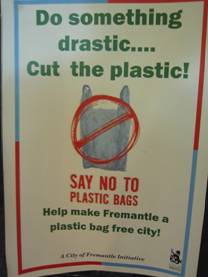General Article -- Wake-up alarm: Plastics must stop
|

“No I don’t want a plastic bag, I’ve brought my own handbag,” is a statement that is seldom heard when people go shopping. Everywhere from larris to supermarkets, chemists, grocers, vegetables vendors and restaurants, fast food centers, plastic bags are provided gratis. Even in temples prasad is provided in plastic bags. Convenience comes first whether of the buyer or the seller and the repercussions on the environment are not heeded. A sabziwalla gives different bags for different vegetables and consumers accept it too without any hesitation. “It is convenient to sort out vegetables” says Smt. Kalpana Jariwala, a housewife. Kumari Preeti Gandhi has plastic bags at her home yet every time she comes home with new plastic bags. Neither do we think of reusing plastic bags.
Plastic is now used in almost every item around us whether furniture, building, construction, decorative items, toys, containers, and so on. Plastic is used in automobiles too, structure components or internal engine parts. Milk bags, soft drink crates, ropes, utensils, stationeries and even water is provided in plastic bags and bottles. The world’s annual consumption of plastic material has increased from around 5 million tones in 1950s to nearly 100 million tones today. Every year between 500 billion and 1 trillion plastic bags are consumed worldwide.
Most plastic is non-degradable; however there are two types of degradable plastic – biodegradable plastic and photodegradable plastic. The biodegradable plastic contains both degradable substances and non-degradable substances. “During degradation, decomposable substance will degrade where as the non-decomposable will stay” Shri Gaurang Vasavda, Assistant Scientist, Gujarat Pollution Control Board. Whereas in case of photodegradable plastic presence of light is essential. If the light is not available the plastic will not degrade. While biodegradable plastic and photodegradable plastic is available and is used, its degradation results in production of hazardous substances such as methane gas. Also the common problem for both types of plastic is that the mixture of degradable plastic and non-degradable plastic may complicate plastic sorting system. The dumping of plastic in landfill reduces land fertility.
Plastic, be its production, use or disposal has a negative environmental impact. Production of plastic requires significant quantities of nonrenewable fossil fuels both as raw material and as a fuel. It is estimated that 4% of world’s annual oil production is used as raw material and about 3% to 4% as fuel. Disposal of plastic is major cause of worry. “Approximately 50 tones of plastics waste is generated daily in Surat,” says Shri Madhukar Gandhi, Director, pollucan Lab. Pvt. Ltd. Plastic is found in landfills, stuck on trees or floating in oceans. Sea animals eat them resulting in choking and death while kilos of plastic has been removed from cows by vets. “Bags containing food consumed stray animal is hazardous to them” said Shri Gandhi. The non-food grade and colored plastic bags contains harmful substances such as carcinogens, which causes cancer. These enter the human body through food items like sambhar, pickles and so on and the regular intake of these foods containing carcinogens show it effect in about 20 years.
We should reduce, reuse, recycle plastic but take care to restore, reclaim, regenerate our environment” says Shri Gaurang Vasavada.
Tips that one can follow in day-to-day life:
- Choose goods with lesser plastic packing
- Choose goods that are packed in plastic that is recyclable or can be returned.
- Try to reduce the need to throw away plastic for e.g.
- Take a reusable (cloth, jute or paper) bag.
- Reuse plastic bags.
- Don’t accept bags if you don’t need one.
- Rather than throwing plastic items away, give them to scrap collectors.
- Buy brands that offer refills.
- Prepare cloth bags from cloth for storing vegetables in your fridge.
- Work with local authorities in supporting and helping environment balance.
- Awareness programs in society should be arranged by NGO’s.
- Make your own group among your friends or relatives or in society to support environment balance.
- Children are the futures of tomorrow teach them the importance of conserving the environment.